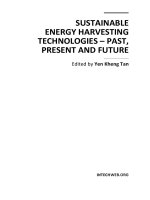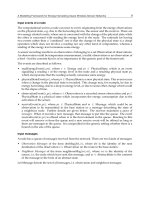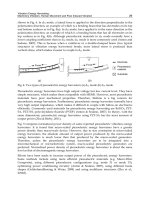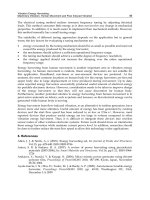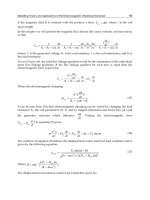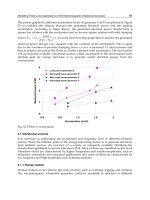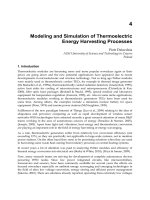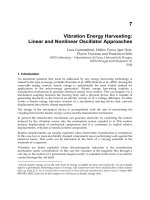Sustainable Energy Harvesting Technologies Past Present and Future Part 12 ppt
Bạn đang xem bản rút gọn của tài liệu. Xem và tải ngay bản đầy đủ của tài liệu tại đây (2.48 MB, 20 trang )
Energy Harvesting Technologies: Thick-Film Piezoelectric Microgenerator
209
The dried paste is then co-fired in a nitrogen atmosphere. The nitrogen must be used
because the filler must not be burnt out before the glass-ceramic has sintered. The process is
repeated to form a multilayer composite film. Finally, the composite film is co-fired in an air
environment, where the carbon filler acting as a sacrificial layer is burnt out without
residues, releasing a composite thick-film free-standing structure. The fabrication steps are
shown in Figure 15. Similarly, the proposed free-standing energy harvester structures as
described in section 3.4 can be fabricated using this technique.
5. Energy harvesters performance comparison
Over the years, many micro-generator prototypes have been fabricated. The most common
vibration energy harvester is based on an electromagnetic principle because at present, the
output powers produced by electromagnetic generators are greater than piezoelectric and
electrostatic based generators. However, with recent improvement in piezoelectric activity
in PZT and the ability to be incorporated within simple cantilever structures, which is
relatively easy to be fabricated and integrated with microelectronic systems, piezoelectric
methods are an attractive alternative for future investigation.
Each of the energy harvesters was being claimed to demonstrate better performance in one
way than another. The most common comparison merit is the electrical output power
density. Although power density comparison can give an idea of the performance of an
energy harvester, it does not explain the influence of the excitation source. As according to
Equation (5), the output power of a resonant device is closely dependent on the amplitude
of an excitation source. However, to make the comparison meaningful, all the energy
harvesters have to be excited at a fixed vibration characteristic (e.g. adjust acceleration level
at resonant frequency of the tested devices to give a fixed vibration amplitude), which is
impossible as the size of the energy harvesters range from micro to centimetre scales
depending on the fabrication technology. Micro-scale devices are more sensitive to micro-
scale vibration amplitudes (a few nano- to micrometer), while centimetre scale devices do
not show their optimum performances if excited at these same levels, therefore it is not
appropriate to make a comparison in terms of power density.
There are other alternative ways to compare the energy harvesters in a more universal
metric, for example, a normalised power density (NPD) suggested by Beeby
et al [2], in
which the power density is divided by the source acceleration amplitude squared. Volume
figure of merit, FoM
V
, suggested by Mitcheson et al [49], measures the performance as a
percentage comparison to its maximum possible output for a particular device. The
maximum possible output is proportional to the resonant frequency of the device to the
power of three and the overall size of a device with an assumption that the device (with a
proof mass) has the density of gold, occupying half of the total volume and the other half is
room for displacement,
4/3 3
0
Measured Power Output
1
16
V
AU
FoM
YVol
ρω
=
(8)
A few recently published experimental results of fabricated energy harvesters are listed and
summarised in Table 2.1. The table is divided into three sections according to the
Sustainable Energy Harvesting Technologies – Past, Present and Future
210
mechanism of power conversion. Each of the micro-generator is identified by the first author
and the year of the publication.
Micro-generator
Power
(μW)
Freq (Hz)
Volume
*
(cm
3
)
Input
Acceln
(m/s
2
)
NPD
(kgs/m
3
)
FoM
V
(%)
Piezoelectric
Glynne-Jones, 2000 [50] 3 80.1 70 NA NA NA
Roundy, 2003 [51] 375 120 1.0 2.5 60 1.65
Tanaka, 2005 [52] 180 50 9 1 20.5 0.26
Jeon, 2005 [11] 1.0 1.4 × 10
4
2.7 × 10
-5
106.8 3.2 1.10
Fang, 2006 [20] 2.16 609 6.0 × 10
-4
64.4 0.9 1.44
Reilly, 2006 [53] 700 40 4.8 2.3 28.2 1.25
Lefeuvre, 2006 [54] 3.0 × 10
5
56 34 0.8 1.42 × 10
4
81.36
Ferrari, 2006 [55] 0.27 41 0.188 8.8 0.018 0.01
Mide, 2010 [56] 8.0 × 10
3
50 40.5 9.8 2.1 0.16
Kok, 2011 [37] 110 155 0.12 4.9 38.2 3.23
Electromagnetic
Ching, 2000 [57] 5 104 1 81.2 7.6 × 10
-4
7.82 × 10
-4
Li, 2000 [58] 10 64 1.24 16.2 0.03
0.01
Williams, 2001 [59] 0.33 4.4 × 10
3
0.02 382.2 1.1 × 10
-4
4.8 × 10
-5
Glynne-Jones, 2001 [60] 5.0 × 10
3
99 4.08 6.9 26.1 1.49
Mizuno, 2003 [61] 4.0 × 10
-4
700 2.1 12.4 1.24 × 10
-6
2.26 × 10
-8
Huang, 2007 [62] 1.44 100 0.04 19.7 0.09 0.07
Beeby, 2007 [2] 46 52 0.15 0.6 884 24.8
Torah, 2008 [63] 58 50 0.16 0.6 1.0 × 10
3
29.4
Ferro Solution, 2008 [64] 1.08 × 10
4
60 133 1 84.4 0.36
Perpetuum, 2009 [65] 9.2 ×10
4
22 130.7 9.8 7.33 0.85
Electrostatic
Tashiro, 2002 [66] 36 6 15 12.8 0.015 0.017
Mizuno, 2003 [61] 7.4 ×10
-6
743 0.6 14.0 6.34 × 10
-8
1.86 × 10
-9
Arakawa, 2004 [67] 6.0 10 0.4 4.0 0.96 0.68
Despesse, 2005 [68] 1.0 × 10
3
50 18 8.8 0.7 0.06
Miao, 2006 [69] 2.4 20 0.6 2.2 × 10
3
8.0 × 10
-7
0.02
Basset, 2009 [70] 0.06 250 0.07 2.5 0.15 4.9 × 10
-3
* Device size does not include the electrical possessing and storage circuits
NA = Data is not available from literature
Table 1. Comparison of a few key experimental energy harvesters.
6. References
[1] Glynne-Jones, P., S.P. Beeby, and N.M. White, Towards a piezoelectric vibration-powered
microgenerator.
IEE Science Measurement and Technlogy, 2001. 148(2): p. 68-72.
[2] Beeby, S.P., Torah, R. N., Tudor, M. J., Glynne-Jones, P., O'Donnell, T., C.R. Saha, and S.
Roy,
A micro electromagnetic generator for vibration energy harvesting. Journal of
Micromechanics and Microengineering, 2007. 17(7): p. 1257-1265.
[3] Mitcheson, P.D., Miao, P., Stark, B. H., Yeatman, E. M., A.S. Holmes, and T.C. Green,
MEMS electrostatic micropower generator for low frequency operation. Sensors and
Actuators A: Physical, 2004. 115(2-3): p. 523-529.
Energy Harvesting Technologies: Thick-Film Piezoelectric Microgenerator
211
[4] Wang, L. and F.G. Yuan, Vibration energy harvesting by magnetostrictive material. Smart
Materials and Structures, 2008. 17(4): p. 045009.
[5] Polla, D.L. and L.F. Francis,
Processing and characterization of piezoelectric materials and
integration into microelectromechanical systems.
Annual Review of Materials Science,
1998. 28: p. 563-597.
[6] White, N.M. and J.D. Turner,
Thick-film sensors: past, present and future. Meas.Sci.Technol.,
1997. 8: p. 1-20.
[7] Hoffmann, M., Kuppers, H., Schneller, T., Bottger, U., Schnakenberg, U., W. Mokwa, and
R. Waser.
A new concept and first development results of a PZT thin film actuator A new
concept and first development results of a PZT thin film actuator
. in Applications of
Ferroelectrics, 2000. ISAF 2000. Proceedings of the 2000 12th IEEE International
Symposium on
. 2000.
[8] Roundy, S. and P.K. Wright,
A piezoelectric vibration based generator for wireless electronics.
Smart Materials and Structures, IOP, 2004. 12: p. 1131-1142.
[9] Sodano, H.A., G. Park, and D.J. Inman,
Estimation of electric charge output for piezoelectric
energy harvesting.
Strain, 2004. 40: p. 49-58.
[10] Yalcinkaya, F. and E.T. Powner,
Intelligent Structures. Sensor Review, 1996. 16: p. 32-37.
[11] Jeon, Y.B., Sood, R., J.h. Jeong, and S.G. Kim,
MEMS Power Generator with Transverse
Mode Thin Film PZT.
Sensor and Actuators A, 2005(122): p. 16-22.
[12] Fritz, J., et al.,
Translating Biomolecular Recognition into Nanomechanics. Science, 2000.
288(5464): p. 316-318.
[13] Mason, W.P.,
Piezoelectric crystals and their application to ultrasonics. 1950: D. Van
Nostrand Company Inc.
[14] Bernstein, J.J., Bottari, J., Houston, K., Kirkos, G., Miller, R., Xu, B., Y. Ye, and L.E. Cross.
Advanced MEMS ferroelectric ultrasound 2D arrays. in Ultrasonics Symposium, 1999.
Proceedings. 1999 IEEE
.
[15] Jordan, T.L. and Z. Ounaies,
Piezoelectric Ceramics Characterization. 2001, NASA/CR-
2001-211225 ICASE Report, No. 2001-28.
[16]
High Quality Components and Materials for The Electronic Industry. 2003, Ferroperm
Piezoceramics.
[17] Kawai, H.,
The piezoelectricity of poly(vinylidene fluoride). Jpn.J.Appl.Phys., 1969. 8: p. 975.
[18] Fu, Y., Harvey, Erol C., M.K. Ghantasala, and G.M. Spinks,
Design, fabrication and testing
of piezoelectric polymer PVDF microactuators.
Smart Materials and Structures, 2006.
15(1): p. S141-S146.
[19] Arshak, K.I., D. McDonough, and M.A. Duncan,
Development of new capacitive strain
sensors based on thick film polymer and cermet technologies.
Sensors and Actuators A.,
2000. 79: p. 102-114.
[20] Fang, H.B., Liu, Jing Quan, Xu, Zheng Yi, Dong, Lu, Wang, Li, Chen, Di, B.C. Cai, and
Y. Liu,
Fabrication and performance of MEMS-based piezoelectric power generator for
vibration energy harvesting.
Microelectronics Journal, 2006. 37(11): p. 1280-1284.
[21] Atkinson, G.M., Pearson, R. E., Ounaies, Z., Park, C., Harrison, J. S., W.C. Wilson, and
J.A. Midkiff,
Piezoelectric polyimide MEMS process. NASA 11th Symposium: May 28 -
29, 2003.
[22] Jaffe, H.,
Piezoelectric Ceramics. Journal of The American Ceramic Society, 1958. 41(11): p.
494-498.
Sustainable Energy Harvesting Technologies – Past, Present and Future
212
[23] Jaffe, B., Cook Jr, W. R., Jaffe, H., J.P. Roberts, and P. Popper, Piezoelectric Ceramics. 1971,
London: Academic Press Inc.
[24] Giurgiutiu, V. and S.E. Lyshevski,
Electroactive and Magnetoactive Materials, in
Micromechatronics: modeling, analysis, and design with Matlab. 2003, CRC Press. p. 357-
415.
[25]
Piezoelectric ceramics data book for designers. 1999, Morgan Electroceramics.
[26] Van Lintel, H.T.G., F.C.M. Van De Pol, and S. Bouwstra,
A piezoelectric micropump based
on micromachining of silicon.
Sensors and Actuators, 1988. 15(2): p. 153-167.
[27] Erturk, A., J. Hoffmann, and D.J. Inman,
A piezomagnetoelastic structure for broadband
vibration energy harvesting.
Applied Physics Letters, 2009. 94(25): p. 254102-3.
[28] Anton, S.R. and H.A. Sodano,
A review of power harvesting using piezoelectric materials
(2003–2006).
Smart Materials and Structures, 2007. 16(3): p. R1-R21.
[29] Liao, Y. and A. Sodano,
Optimal parameters and power characteristics of piezoelectric energy
harvesters with an RC circuit.
Smart Mater.Struct., 2009. 18(045011).
[30] Williams, C.B. and R.B. Yates,
Analysis of a micro-electric generator for microsystems.
Transducers 95/Eurosensors IX, 1995: p. 369-372.
[31] duToit, N.E., B.L. Wardle, and S.G. Kim,
Design Considerations for MEMS-Scale
Piezoelectric Mechanical Vibration Energy Harvesters.
Integrated Ferroelectrics,
2005(71): p. 121-160.
[32] Erturk, A. and D.J. Inman,
A Distributed Parameter Electromechanical Model for
Cantilevered Piezoelectric Energy Harvesters.
Journal of Vibration and Acoustics, 2008.
130(4): p. 041002-041015.
[33] Erturk, A. and D.J. Inman,
Issues in mathematical modeling of piezoelectric energy harvesters.
Smart Materials and Structures, 2008. 17(6): p. 065016.
[34] Roundy, S., P.K. Wright, and J. Rabaey,
A study of low level vibrations as a power source for
wireless sensor nodes.
Computer Communications, 2003. 26: p. 1131-1144.
[35] Sodano, H.A., D.J. Inman, and G. Park,
Comparison of piezoelectric energy harvesting
devices for recharging batteries.
Journal of Materials Science: Materials in Electronics,
2005. 16: p. 799-807.
[36] Wang, Z. and Y. Xu,
Vibration energy harvesting device based on air-spaced piezoelectric
cantilevers.
Applied Physics Letters, 2007. 90(26): p. 263512-263513.
[37] Kok, S.L., White, N. and Harris, N. Fabrication and characterisatin of free-standing,
thick-film piezoelectric cantilevers for energy harvesting. Measurement Science and
Technology, 20(124010).
[38] Larry, J.R., R.M. Rosenberg, and R.O. Uhler,
Thick-film technology: an introduction to the
materials.
IEEE Trans.on Components, Hybrids, and Manufacturing Technology,
1980. CHMT-3(3): p. 211-225.
[39] Brignell, J.E., N.M. White, and A.W.J. Cranny,
Sensor applications of thick-film technology.
Communications, Speech and Vision, IEE Proceedings I, 1988. 135(4): p. 77-84.
[40] White, N.M. and J.E. Brignell,
A planar thick-film load cell. Sensors and Actuators, 1991.
25 - 27: p. 313-319.
[41] Arshak, K.I., Ansari, F., McDonagh, D. and D. Collins,
Development of a novel thick-film
strain gauge sensor system.
Measurement Science and Technology, 1997. 8(1): p. 58-
70.
[42] Baudry, H.,
Screen-printing piezoelectric devices. Proc.6th European Microelec.Conf., 1987:
p. 456-463.
Energy Harvesting Technologies: Thick-Film Piezoelectric Microgenerator
213
[43] White, N.M., P. Glynne-Jones, and S.P. Beeby, A novel thick-film piezoelectric micro-
generator.
Smart Mater.Struct., 2001. 10: p. 850-852.
[44] Koplow, M., Chen, A., Steingart, D., P. Wright, and J. Evans.
Thick film thermoelectric
energy harvesting systems for biomedical applications
. in Proceedings of the 5th
International Workship on Wearable and Implantable Body Sensor Networks
. 2008.
[45] Hill, M., Townsend, R. J., Harris, N. R., White, N. M., S.P. Beeby, and J. Ding.
An
ultrasonic MEMS particle separator with thick film piezoelectric actuation
. in IEEE
International Ultrasonics Symposium, 18-21 Sept 2005, Rotterdam, Netherlands
. Sept.
2005.
[46] Hale, J.M., White, J. R., R. Stephenson, and F. Liu,
Development of piezoelectric paint thick-
film vibration sensors.
J. Mechanical Engineering Science, 2004. 219(1/2005).
[47] Schmid, S. and C. Hierold,
Two Sacrificial Layer Techniques for The Fabrication of Free-
standing Polymer Micro Structures.
MicroMechanics Europe Workshop,
Southampton, 2006: p. 177-180.
[48] Stecher, G.,
Free Supporting Structures in Thick-Film Technology: A Substrate Integrated
Pressure Sensor.
6th European Microelectronics Conferences, Bournemouth, 1987: p.
421-427.
[49] Mitcheson, P.D., Yeatman, E. M., Rao, G. K., A.S. Holmes, and T.C. Green,
Energy
Harvesting From Human and Machine Motion for Wireless Electronic Devices.
Proceedings of the IEEE, 2008. 96(9): p. 1457-1486.
[50] Glynne-Jones, P., El-Hami, M., Beeby, S., James, E. P., Brown, A. D., M. Hill, and N.M.
White.
A vibration-powered generator for wireless microsystems. in Proc. Int. Symp.
Smart Struct. Microsyst. Hong Kong
. Oct. 2000. Hong Kong.
[51] Roundy, S., P.K. Wright, and J.M. Rabaey,
Energy scavenging for wirless sensor networks.
Vol. 1st edition. 2003, Boston, MA: Kluwer Academic.
[52] Tanaka, H., Ono, G., T. Nagano, and H. Ohkubo,
Electric power generation using
piezoelectric resonator for power-free sensor node
, in Proc. IEEE Custom Integr. Circuits
Conf.
2005. p. 97 - 100.
[53] Reilly, K.E. and P. Wright.
Thin film piezoelectric energy scavenging systems for an on chip
power supply
. in Proc. Int. Workshop Micro Nanotechnlo. Power Generation Energy
Conversion Applicat., Berkeley, CA
. Dec. 2006.
[54] Lefeuvre, E., Badel, A., Richard, C., Petit, L. and Guyomar, D.,
A comparison between
several vibration-powered piezoelectric generators for standalone systems.
Sensor and
Actuators A, Phys., 2006. 126 (2): p. 405 - 416.
[55] Ferrari, M., Ferrari, V., D. Marioli, and A. Taroni,
Modeling, Fabrication and Performance
Measurements of a Piezoelectric Energy Converter for Power Harvesting in Autonomous
Microsystems.
IEEE Trans.on Instrumentation and Measurement, 2006. 55(6): p.
2096-2101.
[56] Mide.
Volture PEH25w online datasheet :
[cited 2010 11 January].
[57] Ching, N.N.H., et al.
PCB integrated micro-generator for wireless. in Proc. Int. Symp. Smart
Struct., Hong Kong SAR
. Oct. 2000.
[58] Li, W.J., Wen, Z., Wong, P. K., G.M.H. Chan, and P.H.W. Leong.
A micromachined
vibration-induced power generator for low power sensors of robotic systems
. in Proc. World
Automat. Congr. 8
th
Int. Symp. Robot. Applicat., Maui, HI. Jun. 2000.
Sustainable Energy Harvesting Technologies – Past, Present and Future
214
[59] Williams, C.B., Shearwood, C., Harradine, M. A., Mellor, P. H., T.S. Birch, and R.B.
Yates,
Development of an electromagnetic micro-generator. IEE Proceedings - Circuits,
Devices and Systems, 2001. 148(6): p. 337-342.
[60] Glynne-Jones, P.,
Vibration powered generators for self-powered microsystems, in PhD Thesis,
School of Electronics and Computer Science
. 2001, University of Southampton.
[61] Mizuno, M. and D.G. Chetwynd,
Investigation of a resonance microgenerator. J.
Micromech. Microeng., 2003. 13: p. 209 - 216.
[62] Huang, W.S., Tzeng, K. E., M.C. Cheng, and R.S. Huang,
A silicon MEMS micro power
generator for wearable micro devices.
J. Chin. Inst. Eng., 2007. 30(1): p. 133 - 140.
[63] Torah, R., Glynne-Jones, P., Tudor, M., O'Donnell, T., S. Roy, and S. Beeby,
Self-powered
autonomous wireless sensor node using vibration energy harvesting.
Measurement
Science and Technology, 2008. 19(12): p. 125202.
[64] Ferro-Solutions.
VEH-360 online datasheet:
/> 2008 [cited 2010 12 Jan.].
[65] Perpetuum.
PMG37 online datasheet: />%20Technical%20Datasheet.pdf.
2009 [cited 2010 12 Jan].
[66] Tashiro, R., Kabei, N., Katayama, K., Ishizuka, Y.,, F. Tsuboi, and K. Tsuchiya,
Development of an electrostatic generator that harnesses the ventricular wall motion. Jpn.
Soc. Artif. Organs, 2002. 5: p. 239 - 245.
[67] Arakawa, Y., Y. Suzuki, and N. Kasagi.
Micro seismic power generator using electret
polymer film
. in Proc. 4
th
Int. Workship Micro and Nanotechnology for Power Generation
and Energy Conversion Applicat. Power MEMS, Kyoto, Japan
. Nov. 2004.
[68] Despesse, G., Chaillout, J., Jager, T., Leger, J. M., Vassilev, A., S. Basrour, and B. Charlot.
High damping electrostatic system for vibraiton energy scavenging. in Proc. 2005 Joint
Conf. Smart Objects Ambient Intell. -Innov. Context-Aware Services: Usages Technolo.,
Grenoble, France
. 2005.
[69] Miao, P., Mitcheson, P. D., Holmes, A. S., Yeatman, E. M., T.C. Green, and B. Stark,
MEMS inertial power generators for biomedical applications. Microsyst Technol, 2006.
12(10-11): p. 1079-1083.
[70] Basset, P., Galayko, D., Mahmood Paracha, A., Marty, F., A. Dudka, and T. Bourouina,
A batch-fabricated and electret-free silicon electrostatic vibration energy harvester. J.
Micromech. Microeng., 2009. 19.
9
Hydrogen from Stormy Oceans
Helmut Tributsch
Retired from Free University Berlin, Institute for Physical and Theoretical Chemistry,
and Helmholtz-Centre Berlin for Materials and Energy,
Germany
1. Introduction
The recent nuclear accident of Fukushima, Japan, which has hit a highly industrialized and
technically advanced country, as a consequence of a natural disaster, has significantly
altered worldwide opinions on possible energy strategies for the future. For many decision
makers nuclear energy was a feasible large scale technology for bridging the time until
cheap sustainable energy would be available sometime in the future. The advanced
technology of nuclear energy and the high energy density generated convinced them in
spite of the fact, that no safe solution is still available for handling radioactive waste and
that the availability of uranium is limited. Now the prospect of operating up to 20.000
nuclear reactors on earth to provide a reasonable contribution to the world`s huge energy
consumption (estimated 45 TW, terawatt, by the end of this century) is frightening many
people. Highly developed countries like Germany, Swizzerland and Italy have already
voted to search for an energy future without nuclear energy. This, however, poses a
significant challenge. The development of sustainable energy sources must proceed in a
much more aggressive way. And there is the question, whether highly subsidized solar
technologies like photovoltaics can be preferred choices on a shorter term in a massive effort
towards clean energy. Industrialized countries may be able to afford such subsidized
energy, but poor countries are not. And what the industrialized world mostly needs are
sustainable fuels for transport and chemical industry. What would be the most efficient and
the least costly path towards a sustainable energy economy?
The author has recently studied this question and came to the conclusion that industrial
society should make a bio-mimetic, or bionic approach for solving its energy problems
(Tributsch 2011). Living nature has not only adapted an originally hostile climate of our
planet to favourable living conditions. It has also succeeded in supplying to living beings
both abundant fuels and chemicals in an entirely sustainable way. The strategy adopted was
to split water with solar light, but then to attach the liberated hydrogen to a carbon
containing energy carrier, carbon dioxide. Starting from the resulting carbohydrates all
needed fuels and chemicals could be synthesized in an entirely sustainable way.
It is true that at present we do not have the technology to split water directly with light
using a suitable catalyst. But we could use other technological strategies such as electricity
generated from wind and other sustainable sources to produce hydrogen from water. Only
gasified biomass is presently available as a sustainable carbon containing molecular carrier
Sustainable Energy Harvesting Technologies – Past, Present and Future
216
and this resource is limited so that artificial techniques for biomass generation will be
needed in the future (Tributsch, 2011). Using Fischer –Tropsch synthesis pathways,
hydrogen may be combined with gasified biomass to yield any type of carbon containing
energy carrier or chemical.
From such biomimetic considerations on energy technologies it became clear that an
abundant supply of cheap hydrogen is the real bottleneck for a future worldwide
sustainable energy economy. Today hydrogen is produced from methane. Photovoltaic and
wind electricity for water splitting to obtain hydrogen is still too expensive for commercial
applications. If cheap hydrogen would be available, affordable sustainable carbon based
fuels and chemicals could also be produced. A key advantage of such a fuel technology
would be that all our present fossil fuel infrastructure could be maintained. This would be
an enormous economic and strategic advantage. The energy infrastructure would, on the
other hand, have to be changed if a pure hydrogen economy would be introduced, which
would also be possible and interesting. Nevertheless, hydrogen is a technically favoured
energy carrier. It is easy to handle as a gas and it is environmentally friendly. In the case of a
pure hydrogen economy, however, a parallel carbon based fuel cycle would additionally be
needed to supply chemical industry with carbon containing chemicals.
A recent study was published on mechanisms for solar induced hydrogen liberation from
water (Tributsch, 2008). There is still significant research needed, but prospects are
remarkable for this technology. Artificial model systems based on two photovoltaic cells in
series for water splitting have yielded a solar energy conversion efficiency of 18 % for
hydrogen generation (Licht et al., 2000). This is 36 times higher than the 0.5% efficiency
reached for biomass production via three harvests during one year of sugar cane in a
tropical agricultural region. And artificial light-induced generation of hydrogen would not
require fertile land. Methods of photo-induced solar hydrogen generation have definitively
a future.
But technologies using direct solar light for hydrogen generation are presently much to
expensive because solar energy influx has a low density, 1 kW/m
2
at noon, which has to be
further reduced by a factor of 5-7 because of the sun movement and the day-night cycle (to
an averaged influx of solar energy of only 142-200 W/m
2
). Commercial photovoltaic devices
today only convert 10-15% of this energy. Wind energy systems may work day and night
with favourable technical efficiency and typically operate in energy density ranges between
poor wind conditions of 150 W/m
2
to good ones of 350 W/m
2
and excellent wind conditions
of 500 W/m
2
.
Wave energy technology is based on utilization of kinetic energy of water, which has an 800
times higher density than air. A wave of 3 m can therefore supply an energy density of 36
kW per meter of wave crest. A 6 m high wave already yields an energy density of 180
kW/m. This explains why wave energy is a potentially much more economic sustainable
energy source than wind (fig. 1). Smaller and thus cheaper devices can be applied for energy
harvesting. Compared to wind energy wave technology is however not yet a mature
technology. It is still to be located at the beginning of a longer learning curve. Different
function principles for wave energy harvesting devices are still being explored and
compared. They are typically based on oscillating water columns, multi-body hinged
devices, or overtopping systems, and the installations are typically located at or near the
Hydrogen from Stormy Oceans
217
coast to deliver energy directly via electrical cable. Problems, such as matching the resonant
frequency of wave energy device to wave frequency, efficiency optimization, survivability
of devices and materials in agitated sea water are still being studied. There is a lot of
valuable information available in the literature on wave energy and its technology (e.g.
Cruz, 2008; McCormick, 2007).
The present contribution does not aim at our present wave technology, but at identifying
and discussing the most efficient and potentially cheapest hydrogen production technology
via wave energy far away from coast areas in stormy oceans. Ocean regions with the highest
possible energy density for wave technology will be considered in order to explore its
technical and economic potential. Hydrogen generation from waves in stormy seas far away
from ocean shores has, to our knowledge, not yet been considered as a technological option.
But such an extreme technical situation of a stormy ocean has been selected here as a probe
towards a massive new generation strategy for sustainable and economic fuel.
2. The potential of open sea wave energy
The total solar power incident on the earth has been estimated to amount to approximately
174.000 TW (10
12
W = 1TW = terawatt). Sometimes a value of 121.000 TW is given, which
considers that approximately 30% of the radiation is again reflected into space and not
absorbed on the earth surface (fig. 1). For comparison, energy consumption by man
presently amounts to 15 TW, with 2 TW accounting for electrical energy. This amount is
more than 8000 times smaller than the solar energy absorbed on earth. By the end of the
century mankind is however expected to consume approximately 45 TW, with 6 TW
accounting for electric energy. Years ago it has been estimated by geophysicists that
approximately 2% of the solar power absorbed on the earth surface is converted into
mechanical energy of wind, waves and ocean currents. This would amount to
approximately 2420 TW. Maybe up to 0.6% of the absorbed solar power could be converted
into waves. This rough estimate yields approximately 726 TW, much more than mankind
consumes. The Open University in GB teaches in an introduction to energy sources, that a
global wind power of as much as 10.000 TW (5.7% of the incident solar energy) could be
available. The global wave power was estimated at 1000 TW. (Openlearn, 2011). A power
share of 300 TW is assumed to be available as kinetic energy on the earth surface by Twidell
and Weir (2006). Lueck and Reid estimated the downward atmosphere-ocean mechanical
energy flux to 510 TW. However not more than 10% of the energy, 51 TW, is expected to
enter the ocean (Lueck and Reid, 1984).
These relatively high values for the global wave energy potential have to be confronted with
specialized studies on availability of wave power. In 1976 Panicker estimated the resource of
wave energy in ocean waters with a depth of more than 100 m to approximately 1-10 TW.
Also Issaacs and Seymour (Isaacs and Seymour, 1973) limited the global wave power
potential to only 1-10 TW. This order of magnitude was recently confirmed by a quite
elaborate study based on evaluation of a huge set of data on waves from satellite altimeter
and buoy data (the WorldWaves data base, Topex/Poseidon (1992-2002), Jason-1 (2002-
2006)) (Mork et al., 2010). These authors estimated a global wave power potential of only 3.7
TW. The World Energy Council appears to confirm that order of magnitude by assuming a
wave energy potential of approximately and exceeding 2 TW. A potential of 2 TW has
already been estimated just for the global coastal wave power potential (Previsic, 2004). The
Sustainable Energy Harvesting Technologies – Past, Present and Future
218
wave power potential of the open ocean must be much larger, not only because of the much
larger area but also because of much higher waves and all year round wave activity close to
arctic and antarctic regions (Topex Poseidon radar data).
Compared to the 121.000 TW solar energy input an estimate of 3.7 TW global wave power
appears to be rather modest (a fraction of only 1.65 10
-5
). This can be shown with some very
simple considerations. If 3.7 TW are divided by the surface area of world oceans (361.2
million square kilometres) a medium wave energy of only 0.01 W/m
2
results. If 3.7 TW
would be distributed on, let us say, 5% of the sea surface, where 4-6 m waves are known to
occur practically all year around (Topex/Poseidon data), an average areal energy density of
only 0.2 W/m
2
would be obtained. Such waves would barely be visible – in contrast to the
large waves in huge areas on the open sea, such as in the roaring forties.
The global wave power of 3.7 TW reported appears to be too low compared to typical near-
coast wave power of 30-40 kW/m or up to 200 kW/m in a stormy open sea. A 3 meter high
wave has typically a wave length of 10 m and appears with a frequency of 0.2 Hz. Its power
per crest length of 30-40 kW/m would have to be multiplied by 0.13 s to reach a much lower
areal wave energy density of 3.9-5.2 kWs/m
2
(see formula below). The power, per m
2
of
surface area, present in form of kinetic and potential energy of the wave would thus be 3.9-
5.2 kW/m
2
. Assuming a 4 kW/m
2
energy density of a wave field, 250 km
2
would already
add up to 1TW. For a commercial harvest of such an amount of power maybe an area of
1000 km
2
would be needed. As the global wave power distribution on the world map (for
example fig. 2 of Mork et al, 2010) visualizes, immensely much larger areas show measured
wave power of 30-40 kW/m (crest length) or higher. It is therefore not clear, why a global
wave power potential of only 3.7 TW is obtained.
The low estimated wave energy potential in some studies also contradicts a comprehensive
estimate of wind power over land and near-shore, which yields a power of 72 TW (Archer
and Jacobson, 2005). Wind power over the ocean should be significantly higher.
Other approaches to estimating global wave power consider the wind energy input by
calculating energy transfer to the ocean surface with theoretical models (Teng et al., 2009).
With a wind energy input of 57 TW, determined for 2005, the energy dissipation in deep sea
water was calculated to 33 TW, 58% of the wind energy input. Since the ocean surfaces are
much larger than the land surfaces, the estimate of 57 TW may be too low compared to the
72 TW estimated for over land and near shore wind potential, cited by Archer and Jacobson
(2005).
From this discussion of available information on global wave energy it may be concluded
that insufficient and in part contradictory information exists and more experience is needed
to reach an objective picture on the global potential of open sea wave power. On the basis of
above given information and arguments it is our understanding that open ocean wave
power may be of the order of 10-50 TW, much higher than the 3.7 TW estimated by Mork et
al. (2010). Regardless the contradictory estimations of global wave power it can be
concluded, that a significant portion of mankind’s power consumption may be derived from
such a sustainable energy source. It can be considered to be a concentrated secondary solar
energy, mediated by inhomogeneous heat generation and evaporation processes in the earth
biosphere.
Hydrogen from Stormy Oceans
219
3. From near coast to open sea wave energy harvesting
Wave energy technology today is an on-shore or near shore technology, which converts
mechanical energy of waves into electrical energy. This electrical energy is typically supplied
to the land via an electrical cable. Wave energy is, as already mentioned, still an emerging
technology which is still searching for the most adapted technical devices. It is also facing
problems, such as material durability and destruction of technical installations in unusually
big storms. A limitation of this technology is also the choice of coastal sites, which may
compete with other interests and applications. Another one is a reduced height of waves, due
to typically flat water near the coast. In populated coastal regions such as in Europe, or Central
and North America, where wave power plants are presently installed and operated, the
weather is typically such that larger waves are only present during part of the year.
Fig. 1. Scheme visualizing solar energy input on earth and activation of mechanical energy
with specification of energy densities encountered for energy harvesting
Sustainable Energy Harvesting Technologies – Past, Present and Future
220
In order to get the most out of wave energy one should focus on ocean areas with very high
waves, which, in addition, are present all over the year. As Topex/Poseidon and Jason-1
radar data show, such areas exist mostly north of the Antarctic continent in the roaring
forties, south of Africa and Australia as well as near the southern tip of South America. Such
areas of permanent intensive waves also exist close to the arctic circle. At present, there is no
ocean wave project known to the author, which is aiming at energetic exploitation of these
remote stormy oceans. When changing from a 3 m to a 6 m wave the energy density is
increasing five-fold, but simultaneously the wave frequency is decreasing from
approximately 0.2 Hz to 0.1 Hz. The resulting energy increase by a factor of approximately
2.5 has additionally to be multiplied by a factor of at least two because of the round the year
wave presence in stormy oceans, in contrast to most present sites of wave energy
exploitation. The approximately fivefold total increase of energy density is a good
precondition for the economic feasibility of this high wave technology approach, as
compared to conventional wave energy exploitation, besides of the availability of huge
ocean areas for energy harvesting. But the key challenges that remain to be addressed are
the survival of the wave technology in the highly stormy environment and the energy
transport to industrial destinations.
In order to discuss these subjects it should be helpful to get first acquainted with some
essential properties of waves as depicted in fig. 2. A water wave is a periodical
phenomenon with very special behaviour. It is typically generated by wind due to the
friction between air and the water surface. The mechanism of water wave generation is
highly non-linear and very complex (e.g. Johnson, 1997; Falnes, 2002). Waves can develop
highly divers pattern. They are, to a large extent, a far from equilibrium phenomenon and
part of their properties can only be adequately understood on the basis of dynamic self
organization concepts.
The distance between through and crest of a wave, as shown in fig. 2 is the wave height,
while the typically used significant wave height is the average height of the highest one
third of the waves in a system. The wave length is the distance between two crests, and the
period T the time passing between two passages of crests. This period changes with wave
height. It approximately triples when the wave height increases from 0.5 to 6 m.
Simultaneously the wave length, the distance between two crests, increases from
approximately 15 m to 110 m. When waves are passing, this observed kinetic movement of
waves, 5 m/s to 13 m/s for the above two situations, is accompanied only by elliptical
movements of water molecules (fig. 2). These movements become smaller towards the depth
of the sea and practically stop in a distance of approximately a half wave length from the sea
surface. In detail, a water particle moves slightly forward with the rising front of the wave,
backward with the falling back side of the wave. All together the water molecule at the top
of the wave only slightly moves forward as the wave passes. For 5 m high waves, which
generate a power of 125 kW/m of crest length (see below), the water movements cease in
approximately 45 m depth. The power obtainable from waves per unit of wave crest length
is proportional to the square of wave height (Fig. 2) and follows the following formula (P =
wave energy power per unit of wave crest length, ρ = water density, g = acceleration by
gravity, H = significant wave height, T = wave period)(e.g. Dean and Dalrymple, 1991;
Komen et.al, 1994)
Hydrogen from Stormy Oceans
221
P =
ρ
g
2
64
π
H
2
T
(1)
For a 5 m wave this power per unit crest length yields 125 kW per meter of crest length.
In order to calculate the energy density E contained per unit horizontal area, we have to
calculate the sum of kinetic and potential energy of the wave:
E =
1
16
ρ
gH
2
(2)
Inserting (2) into (1) yields the following relation in the dimension of kWs/m
2
:
⎡
⎤
⎢
⎥
⎣
⎦
2
P
kWs
E=1.28
Tm
(3)
A period T of 10 s can reasonably be assumed for 5 m waves, changing relation (3) into
E = 0.128 P (kWs/m
2
).
Taking the energy density per unit time, seconds, E/s yields the power of the wave per
horizontal unit surface area. When the power, contained in a 5 m wave pattern is calculated
per square meter of ocean, a value of approximately 16 kW/m
2
is thus found. This power
can be present day and night, while the maximum solar power (at noon) is only 1 kW/m
2
,
and for a day-night average has to be divided by an additional factor of at least 5, yielding
only 200 W/m
2
. The average power content in 5 m sea waves is therefore exceeding the
average available power in solar intensity by a factor of 80. This shows how much the power
of weak sunlight, which is incident on earth, is finally concentrated via weather activity into
the power of high waves. Via photovoltaic devices sunlight can only be harvested with an
efficiency of now typically 15 %. Wave energy technology, on the other hand, aims at more
than 90 % energy conversion efficiency. This may give another factor of 6 when comparing
incident solar light energy with the energy present in high waves. Multiplying the 80 fold
energy density per square meters of 5 meter waves by a factor of 6 yields a theoretically 480
times higher efficiency for energy harvesting.
Having estimated the power density, per horizontal area, of 16 kW/m
2
of a 5 m wave field
we can now calculate how big the area will be that contains wave energy of one terawatt (1
TW=10
12
W). This ocean area is 60 square kilometres only. Since only a fraction of that
energy can realistically be harvested, a one terawatt (1 TW) seaborne wave power field may
cover an area of 200 to 1000 square kilometres (sqkm). Let us now consider that the total
surface area of the oceans in the world covers 3.6 10
8
sqkm. The violent oceans with 4-6 m
waves, the southern parts (roaring forties) of the Pacific, Indian and Atlantic ocean, a large
portion of the Southern Ocean around the Antarctic continent, as well as significant portions
of ocean around the arctic ice cover may contribute up to 5 % of the ocean surface. That is,
ocean areas with 4-6 m waves (average 5 m), which may prevail at least for a large fraction
of the year, may amount up to 18 .10
6
sqkm (this can, for example, also be verified by
looking at fig. 2 of Mork et al. (Mork et al, 2010) and estimating the area covered by wave
power grid points with more than 40 kW/m of crest length). If 3.7 TW are divided by such
Sustainable Energy Harvesting Technologies – Past, Present and Future
222
an area, an average power per crest length of only 1.56 kW/m is found, much less than the
known wave power of 125 kW/m of crest length for 5 m high waves. A wave power of 1.56
kW/m corresponds to a wave height of the order of only 0.8 m. Such a simple estimation
again puts a question mark to the elaborate global wave power estimation of only 3.7 TW of
Mork et al. (Mork et al., 2010). The global wave power must be much bigger.
These thoughts justify the interest and promise in addressing the challenge of harvesting
wave energy from stormy seas. It is the sustainable energy with the highest energy density
on earth and it is abundant (excluding sporadic heavy storms, such as hurricanes). And it is
localized in remote unpopulated regions of our world. Our energy hungry world would
have a realistic opportunity to tap massive sustainable energy from stormy oceans, if it
develops a serious effort to build up an adequate technology for harvesting it.
Fig. 2. Drawing which explains the physics of water waves with elliptically circulating water
molecules and decreasing movements towards the depth.
4. Challenges and opportunities in stormy seas
As already mentioned, our present, emerging wave energy technology is being developed
for coastal or near-coast applications. If wave technology is projected for the stormy, open
Hydrogen from Stormy Oceans
223
seas, several boundary conditions will change (Fig. 2). One is that in the open sea, with an
average depth of 2000 to 4000 meters the wave energy installations will typically not be
anchored on the ground. They will float and may be positioned via satellite and an inbuilt
propagation system that uses energy gained from wave power. The second important
change will be that the essential wave technological equipment will be placed under water
where the wind driven wave activity is not any more felt. This will protect the technology
from violent storms. Another important difference will be that the wave energy installations
will be so far away from a coast that electrical cables will not be practical and economic. An
energy carrying fuel, hydrogen, will directly be produced via electrolysis of sea water on
site for transport in gas carrying ships or via undersea pipelines. There will be another
difference to conventional near-coast wave energy installations. The fertility of open seas is
known to partially be limited by the lack of structures to anchor or harbour marine species.
Sunken ships have been known to become artificial reefs with abundant sea life. Large scale
open sea wave energy installations may, if properly constructed, become such artificial reefs
with abundant opportunities for fish farming. Such a secondary application may have a
very favourable impact on economics and may, in addition address a very important
emerging problem of mankind. The fish supplies of the oceans are dwindling and world
population may approach 10-12 billion people by the end of this century. Developing large
scale fish farming on the open sea may be a useful investment.
It will not be practical to construct wave energy installations on site in stormy open seas.
Therefore, they should be constructed and finished on assembly lines on far away shipyards
in order to be dropped in the sea to be assembled to a large scale energy field. Figure 3
shows and explains the structure and function of such buoys serving as elements of a large
energy harvesting field. They transfer the movement of the sea waves via the mechanical
forth and back movement of a piston to a large floating underwater body, where electricity
is generated for hydrogen generation from water.
In order to deal with stormy oceans it is necessary to gather reliable information on wave
patterns and behaviour. Waves in the roaring forties, for example, often reach 9 to 12 m
high. Trains of waves of different height and shape arising from different wind patterns
may combine in infinite ways. Crest and through may cancel each other and the height of a
wave on one place will become equal to the combined heights of waves occurring at that
place and time. As a consequence, even 15 to 24 m high waves have occasionally been
observed (Hubbard, 1998).
What wave energy exploitation systems could be employed in stormy oceans? Around 65
wave energy devices are listed by Wave Energy Centre (wavec, 2011), a non profit
organization for the advancement of wave energy technology. Among them are wave
energy harvesting systems such as Pelamis (Ocean Power Delivery Ltd/UK), Powerboy
(Ocean Power Technologies/USA), Wave Dragon (Wave Dragon ApS/Denmark), Wave
Roller (AW-Energy Oy/Finland) and OEbuoy (Ocean Energy Ltd/Ireland). They include
technical principles such as Attenuator Systems, Oscillating Water columns, Overtopping
Devices, Oscillating wave devices, axisymmetrical point absorbers, or submerged pressure
differential devices. The Pelamis system, for example, which is presently being installed in a
commercial wave energy installation in Portugal, is a semi-submerged floating structure
composed of cylindrical steel sections which are linked by hinged joints that contain
hydraulic pumps. Oil under high pressure drives motors that power electricity generators.
Sustainable Energy Harvesting Technologies – Past, Present and Future
224
Not considering the fact that hydrogen and not electricity should be the energy product
from wave energy fields in stormy seas, no such system will probably survive for a long
time, when the wave energy device is floating on the water surface. Powerful waves (e.g. 15
m waves with a period of 15 seconds have a power of 1.7 MW/m of crest length) will earlier
or later damage or destroy them. Most conventional wave energy harvesting devices can
therefore be excluded from operation in violent oceans. High waves in the open ocean
should preferentially be harvested for energy with vertically moving buoys, which are
positioning their essential structural and functional elements under the sea surface in the
quiet water region.
This quiet region will be approximately half a wavelength below the sea level. Only the
swimmer, which is following the periodic wave pattern, will approach and reaches the
water surface. Such a strategy places essential existing technology outside the reach of
storms. The conversion of mechanical energy via a linear generator into electricity for
hydrogen evolution from water should be based on an as simple technology as possible.
Delicate motors, pumps and hydraulic systems should be as much as possible avoided. Only
very simple and durable technology should be applied, because service interventions on a
stormy sea will be a significant challenge.
Fig. 3. Structure and function of buoys designed to harvest energy from high waves in
stormy seas.
An important construction idea is to drop the buoy in such a way into the sea as to keep it
afloat via the swimmer, its floating component. The main submerged body of the buoy
should have such a high inertia, and additionally a high water resistance, while being
Hydrogen from Stormy Oceans
225
structurally linked to neighbouring devices, to keep it largely immobile and reasonably
stable positioned under water. Wave activity above is periodically moving the swimmer up
and down while the submerged energy converting and hydrogen generating counter
structure will remain largely immobile.
The assembly of many buoys to a buoy field and its function is visualized in fig. 4. The
linking together of so many structural and functional wave energy elements will provide the
wave power installation with properties comparable to a submerged island over which the
trains of water waves are drifting. It may be eventually positioned and propelled with an
inbuilt transport and satellite navigation system, supplied by energy generated from waves.
Fig. 4. Wave energy harvesting buoys could be built in mass production and assembled to
large fields which could be kept in place or moved via satellite navigation. Besides of the
swimmers all technical infrastructure is located in the quiet underwater region. It could also
be used in a secondary way for sea food farming installations.
5. Technical infrastructure of open sea wave energy installations
When talking about mechanical under water structures and about difficulties to operate and
maintain them, one should first recall what mankind has accomplished in this field. The
superpowers operate fleets of sophisticated submarines. There are all kind of diving and sea
floor exploring vehicles. Oil and Gas companies are prospecting for fossil fuel, constructing
and maintaining production wells in many ocean regions. Under sea channels link
Sustainable Energy Harvesting Technologies – Past, Present and Future
226
continental Europe with Great Britain and they are found in many other geographical
locations. Ship technology has no mayor problems with stormy oceans. There is no technical
excuse that could make appear a stormy ocean wave energy project a too big technical
challenge for our industrial society.
Fig. 5. Technical infrastructure of wave buoy with linear electric generator for direct
hydrogen generation from sea water. Above: Representative scheme for electric circuits
including linear generator, potentiostat and electrolyser. Below: structural-mechanic set-up
of buoy.
Nevertheless, buoys for high waves should be constructed as simple and technically as
elegant as possible, because they should be exposed to a violent and corrosive seawater
Hydrogen from Stormy Oceans
227
environment and servicing them would appear to be a mayor challenge and would be
costly. A vertically, or better, slightly eccentrically moving buoy (because of elliptical water
trajectories) should provide the simplest approach. Mechanical wave induced periodical
movement could then be directly converted into direct current electricity using a linear
electric generator (fig. 5). It directly converts a back and forth motion into electric energy.
This is a quite well known principle and is based on the relative movement of an electrical
coil and a piston of magnetic material. Is it possible to design a linear, low speed permanent
magnet generator with an inherent low load angle and a satisfactory efficiency? The answer
is positive and was, for example, given in a theoretical study on applicability of such an
electricity generating concept to wave energy harvesting (Danielson, 2003). These
calculations show, that it is possible to construct a permanent magnetic generator of 10 kW
and 78,6 % efficiency with a magnetic piston moving at a speed of only 0.67 m/s. The load
angle, which is relevant for efficiency was found to be satisfactorily low (10.3°). Most losses
are due to heat generation through induction in copper, less in iron. Significant
improvements appear still to be possible.
Another possibility to drive a linear electrical generator via sheltered underwater
technology is the use of a submerged, gas filled vessel which expands and contracts under
the varying ambient pressures produced by above passing waves. This principle is known
as the “Archimedes Wave Swing” (waveswing, 2011). This contraction and expansion can be
transmitted to a linear electricity generator. We consider this technology as more sensitive,
since a gas space of changing volume has to be maintained under water for prolonged
periods. In addition the efficiency will be limited via the constraints of an expanding air
containing vessel, and the infrastructure will be more expensive. The linear generator found
already other applications in the linear generator point absorber (Pointabsorber, 2011) and
the Ocean Wave Energy Web system (oveco, 2011).
Fig. 6. At the coast wave formation and propagation is frequently affected by geological
features of the environment. The transition from a near coast wave energy technology to a
deep sea violent ocean wave energy technology will multiply the available power and open
up huge ocean areas for sustainable energy harvesting. Instead of electricity hydrogen will
become the energy carrier.
Sustainable Energy Harvesting Technologies – Past, Present and Future
228
All complex electric-electronic infrastructure to produce electricity of well defined quality
for hydrogen evolution from sea water in a linear generator wave buoy should be avoided
(fig. 5). Instead, the direct current from the linear generator should immediately be provided
to a simple potentiostat, that controls the electrical parameters of the electrolysis cell, and
passed through suitable cathodes for hydrogen production from sea water (see also below).
The hydrogen would be produced under pressure of several bars, depending on the depth
in which the water electrolyser is functioning. An under water hydrogen collection and
distribution system would finally conduct the hydrogen to a large storage system such as a
properly designed submarine vessel. From here the hydrogen could finally be transported
away by ship or under-sea pipeline. Today large quantities of methane are transported this
way over long distances (200 ships for transport of natural gas) and the economic conditions
should not be much different for hydrogen.
The proposed reasonably simple technological route to generate hydrogen from wave
energy in deep and violent oceans (fig. 5) justifies mayor efforts towards optimization of
technical parts and realization of a pilot installation. As compared to waves near the coast
(fig. 6), the technical parameters for energy harvesting will drastically change. By
positioning most technical infrastructure in deep still water, where it floats, it will easier
survive the impact of storms. And hydrogen instead of electricity transport will secure
energy recovery from wide ocean regions.
6. Sea water electrolysis for hydrogen
The direct current electricity produced by the linear generator can be conditioned and
transformed to be used in an electrolysis cell for decomposition of sea water. Industrial
electrolysis of seawater for hydrogen generation is not an entirely mature technology. When
electric current is passing through water, hydrogen is, as well known, liberated at the
cathode and oxygen at the anode. The hydrogen evolution process is a simple
electrochemical reaction, which does not require noble metals like platinum as an electrode.
Nickel is well suited for technical applications. But oxygen evolution is a demanding four-
electron transfer process. Special catalysts are necessary, which chemically bind water
species during the electrochemical reaction. Typically, transition metal compound are
needed to accomplish this. A quite efficient catalytic electrode is RuO
2
. In presence of NaCl
in the water it also efficiently evolves chlorine, which is technically applied. The problem for
seawater electrolysis is that sodium chloride is dissolved in seawater and that the electrode
potential for evolution and liberation of chlorine gas at the anode is not very distant from
the potential of oxygen evolution from water. If conditions are not properly adjusted
poisonous chlorine gas may thus be liberated in a side reaction. While the electrochemical
potential for oxygen and hydrogen evolution is changing with the pH value by 0.059V per
pH unit, the potential for chlorine evolution does not. It is situated at E°= +1.36 V(NHE =
normal hydrogen electrode). Sea water has typically a pH value between 7.8 and 8.4 and the
oxygen evolution potential is therefore approximately at E° = +0.758 (NHE). The hydrogen
potential is found at E° = - 0.5472 V (NHE). Some complication arises in that in non buffered
sea water hydrogen evolution is accompanied by a pH shift towards alkalinity (relation (5)),
oxygen evolution by a pH shift towards acidity (relation(4 ).
H
2
O Æ ½ O
2
+ 2H
+
+2e
-
(4)
